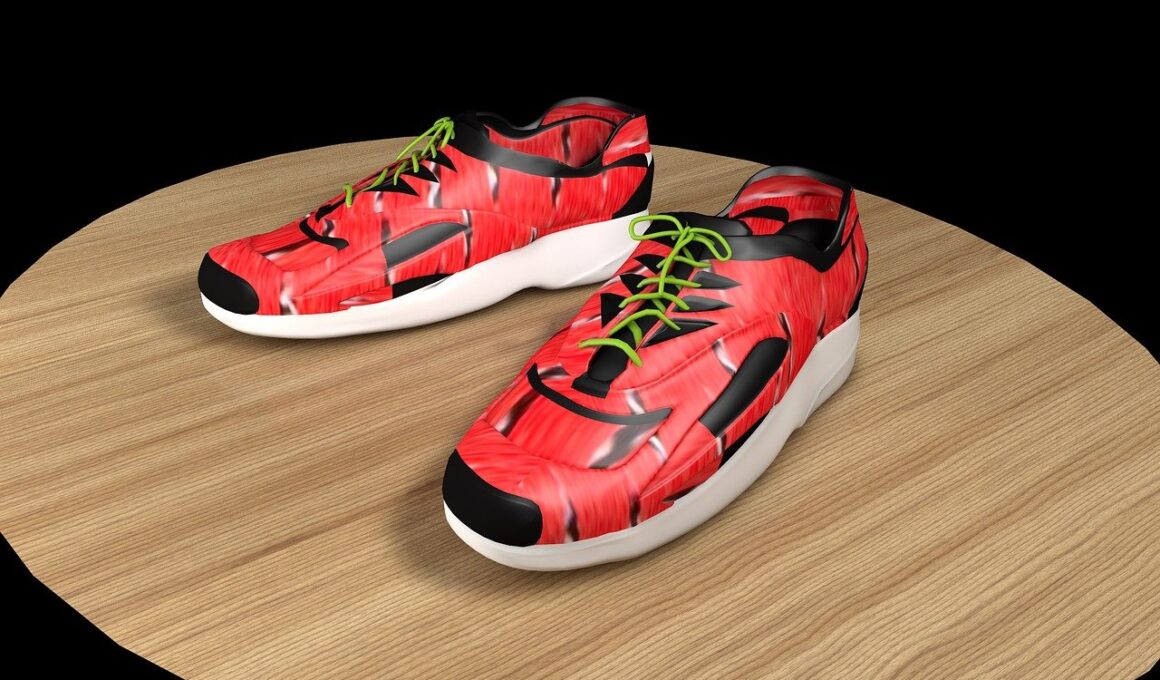Trail Running Shoe Trends to Watch in 2024
As we approach 2024, trail running shoe trends continue to evolve to meet the demands of dedicated outdoor enthusiasts. Footwear manufacturers are focusing on sustainability, integrating eco-friendly materials, and innovative technologies into their designs. For instance, brands are exploring plant-based or recycled components to minimize environmental impact. Additionally, the emphasis on comfort remains paramount, leading to the development of enhanced cushioning systems that promote a soft landing with each stride. Athletes require shoes that allow for flexibility and responsiveness in various terrains. Furthermore, trail running shoes are increasingly offering improved grip through advanced rubber compounds that enhance traction on wet or uneven surfaces. Performance fabrics are also gaining popularity, with moisture-wicking capabilities helping to keep feet dry and prevent blisters over long distances. Lightweight designs remain a staple, allowing runners to achieve greater speeds while preventing fatigue. The blending of style with functionality is becoming more pronounced, catering to both performance needs and aesthetic preferences. Ultimately, the evolution in trail running shoes over the next year will reflect both innovation and a commitment to the environment.
Another significant trend influencing trail running footwear is the rise of personalized options. More brands are embracing tailor-made designs that cater to individual running biomechanics. Shoes that provide custom fits ensure better support and reduced risk of injury by aligning with each runner’s unique foot structure. Moreover, the advancements in 3D printing technology enable rapid prototyping of custom-fit shoes. This personalization not only enhances comfort but also boosts performance, allowing runners to achieve their best on challenging trails. Furthermore, the integration of smart technology is another trend to watch in 2024. Wearable devices are increasingly being paired with footwear, providing real-time data on performance and gait analysis. Some shoe models will feature embedded sensors that track metrics, helping runners optimize their training and prevent injuries. Breathability remains vital, and manufacturers are innovating with mesh uppers to improve airflow. Trail runners can expect more waterproof options as well, balancing protection from elements with moisture management. Innovative color schemes and reflective materials will also be common, improving visibility during dawn or dusk runs, making safety a priority in 2024.
Technological Advancements in Trail Running
The technological advancements in trail running footwear for 2024 underline how important innovation is in this field. Several manufacturers are exploring the use of advanced cushioning technologies that adapt to the terrain, providing support when it’s needed most. For example, dynamic cushioning systems can adjust their firmness based on the surface, thereby offering optimal protection and comfort. Additionally, as runners push boundaries, the development of enhanced energy return features is crucial, allowing for better propulsion with every step. Shoe weight continues to be a critical factor, and brands are working relentlessly to produce lighter materials without compromising strength. Additionally, the use of advanced adhesives and stitching techniques improves durability, which is essential for trail running shoes subjected to abrasive conditions. Collaborations with athletes are fostering designs that meet the rigorous demands of high-performance running while also focusing on aesthetics. This alignment between form and function is likely to attract more runners looking for shoes that not only perform well but also look great. Ultimately, these technological improvements will shape the future of trail running footwear.
On the other hand, traction technology designed for specific terrains will be another focus in 2024. Shoes equipped with specialized outsoles enhance grip and stability across diverse landscapes, from muddy trails to rocky paths. This advancement will help runners tackle obstacles with confidence, ensuring their shoes are equipped for the unpredictability of nature. The trend of integrating multi-directional lugs will become prominent, providing the needed traction for quick turns and rapid descents. Another aspect to consider is the increasing popularity of hybrid trail running shoes. These versatile models can transition seamlessly from rugged off-road environments to urban settings. This duality caters to runners who traverse varied terrains frequently, emphasizing versatility. Adaptable shoes featuring removable insoles or interchangeable components will also gain traction, allowing users to modify their footwear according to personal preferences or changing conditions. Furthermore, shoe longevity is being prioritized, with innovations aimed at enhancing the lifespan of footwear while minimizing waste. An evolving market that meets the diverse needs of trail runners will pave the way for future innovations.
Sustainability Trends in Footwear
In 2024, sustainability will be at the forefront of trail running footwear development. Companies are recognizing the importance of reducing their ecological footprint and are actively seeking sustainable materials. Natural fibers, such as organic cotton and hemp, may be utilized in the upper construction of shoes, providing breathability while being environmentally friendly. Additionally, recycled polyester and rubber will help create shoes that not only perform but also lessen the impact on the planet. Environmental certifications will become a key aspect of a brand’s identity, guiding consumers toward choices that contribute positively to sustainability. The trend of using vegan materials will continue to grow in importance, appealing to conscious consumers who prioritize ethical considerations. Companies are also focused on creating recycling programs, encouraging runners to return their old shoes when purchasing new ones. This initiative promotes a circular economy, where old materials can be transformed into new products. Moreover, brands are investing in transparent supply chains to foster consumer trust, openly sharing their materials’ sourcing processes. Sustainability will shape the industry, becoming a crucial factor for the conscious consumer in 2024.
Customization will not just pertain to fit but will extend to color and design as well, creating a personalized aesthetic that reflects the wearer’s style. Expect to see limited edition models and collaboration shoes featuring exclusive designs that are both stylish and functional. The marketing landscape will adapt, emphasizing unique stories behind each shoe, often tying back to the material origins or the manufacturers’ sustainability efforts. Furthermore, the colors and prints used will reflect current design trends, tapping into the desires of runners who want their footwear to make a statement on the trails. As the sector embraces these non-traditional styles, it will also ensure that these designs uphold performance standards. The combination of custom aesthetics with high-functionality will appeal to a broader demographic of trail runners. Additionally, brands will leverage augmented reality (AR) technology that allows consumers to visualize how shoes will look and fit before purchasing. This advanced shopping experience is likely to enhance customer satisfaction while reducing return rates. Overall, aesthetic choices in 2024 will play a vital role in the trail running footwear market.
The Future of Trail Running Footwear
The future of trail running footwear is set to embrace a holistic approach by blending technology, performance, comfort, sustainability, and style. As trends evolve through 2024, it’s essential for brands to communicate the innovation journey behind each shoe. In doing so, they build deeper relationships with consumers who are eager for products that resonate with their values. Furthermore, with the increased accessibility of global markets, brands will need to cater to diverse preferences, showcasing a wide array of styles and technologies. They will need to adapt to regional demands, ensuring products meet local climate conditions and terrain variations. Embracing feedback from the trail running community will also drive product development, paving the way for footwear that reflects actual user experiences. Along with advancing shoe technologies, education around trail running will become increasingly important, helping newcomers to make informed choices about their footwear. Retailers will play a key role in educating consumers, providing information about shoe types, fit, and maintenance. The coming year will offer exciting developments in trail running shoes, with innovations setting the stage for future adventures.
With the focus on community engagement, expect the growth of active events centered on trail running experiences. Shoe manufacturers likely will sponsor local races, workshops, and community gatherings, bringing runners together. This will create a vibrant culture centered around trail running, fostering camaraderie among athletes and promoting healthy lifestyles. Moreover, partnerships with social media influencers will shape marketing strategies, targeting younger generations. With the integration of technology into running will also encourage fitness tracking, community challenges, and gamified experiences. Brands will harness data analytics to understand consumer behavior better, thereby shaping future releases that align closely with market demands. Additionally, the emphasis on mental health and well-being through outdoor activities will further amplify. Increased awareness about the benefits of nature connection will encourage more individuals to explore trail running, thus expanding the market. So, as we navigate through 2024, the trail running footwear landscape will evolve into an inclusive and innovative realm, influencing not only athletes but also recreational runners. The trends expected to emerge reflect a commitment to performance, sustainability, and community engagement while prioritizing the uniqueness of each runner’s experience.

